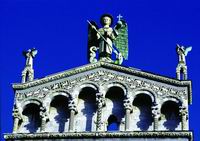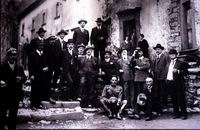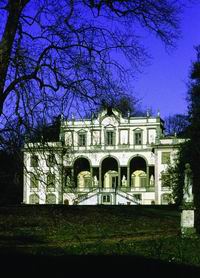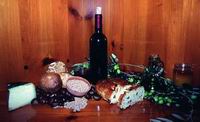|
THE CITY OF LUCCA
It enjoys an enviable position a few minutes away from the sea and less than an hour by car from Florence. It borders on the province of Pisa, and is surrounded by the Apennine mountains and the spurs of the Apuan Alps. Hemmed in by its walls, the city reveals itself a little at a time. Only by walking along the narrow streets of the historic centre and visiting the more than one hundred churches and almost the same number of palaces can one discover the mystery and magic of a past that abounds in the history, culture, and architecture of various epochs. Everything in the city of Lucca is to be seen, because the historical essence of the different styles has given rise to a harmonious building fabric which still today is well preserved and worth seeing.
Every contrast is pleasing to the eye, from the most severe Romanesque to the most sumptuous Renaissance styles: a guiding thread leads those who travel it, an impact that is immediately revealed while walking along the 4 km of Walls that surround the city like an embrace. In fact, Lucca is one of the few italian cities to have preserved intact its own enclosing walls. Under the Bourbon rulers these were transformed into a public walkway, consisting of tree-lined paths where in previous years – believe it or not – car races actually took place.
On entering the city from the south, we encounter piazza Napoleone, also known as “Piazza Grande”. It has been subjected to a restoration that has given it back its original, early 19th century appearance. The west side of the square is entirely occupied by the facade of the Palazzo Pubblico, or Palazzo Ducale. With its vast inside courtyards and magnificent public rooms. On exiting from the opposite side and turning right, we come out in the square containing the church of S. Romano, which was built in the 13th century over a subsequently-restructured oratory that already existed in 792. The single-nave interior with transept became one of the most important examples of baroque in Lucca, thanks to the transformations brought about by the Dominican father, Giovanni Buonvisi, and the Lucchese architect, Vincenzo Buonamici.
Bearing east, we go past the Teatro del Giglio – a 17th century neo-classical building, the work of the Lucchese architect Giovanni Lazzarini: a testimony to Lucca's musical tradition – and the very ancient Church of S. Giovanni, and arrive at the Saint Martino Cathedral, a masterpiece of Romanesque art, with its 13th century facade that abounds in multiform columns and a portico decorated with very fine bas-reliefs. Inside are two of the monuments dearest to the hearts of the Lucchesi: the Volto Santo, a wooden crucifix, and Jacopo della Quercia's masterpiece: the funeral monument to Ilaria del Carretto, the wife of Paolo Guinigi, Lord of Lucca in the early years of the 15th century. To one side, Piazza Antelminelli opens up with its fountain built by the architect Nottolini (1832-35), as testimony to the termination of the works for realising the aqueduct. The Museum of the Cathedral, with its precious historical and artistic patrimony, is also located in the square.
Continuing, we encounter in the middle of the same square the Romanesque Church of Saint Michele in Foro with its magnificent facade of white calcareous stone. It is particularly developed vertically with respect to the other churches in Lucca: a large statue of St. Michael adorns its pinnacle. Situated in the ancient forum of the Roman city, the church rises over a previous contruction that dates back to the 8th century. A short distance away is Palazzo Pretorio, a 16th century edifice under the loggia of which is preserved the monument to Matteo Civitali.
In the immediate vicinity, to the west, is the house where the most famous Lucchese was born: the great composer, Giacomo Puccini. It is now a Museum dedicated to him. Retracing our steps, we encounter the most frequented and animated street in the city: Via Fillungo, the real commercial centre and Lucca's “drawing room”. Via Fillungo leads to piazza Anfiteatro, a square that never ceases to fascinate and amaze. Risen over the original layout of the Roman era, which is still visible on the outside, over the course of the centuries the square has undergone a residential, commercial and artisan stratification that has caused it to assume a unique connotation, with its original elliptical-sharped structure still perfectly recognisable.
Continuing in a northerly direction, Via Fillungo opens out into another very lovely square, Saint Frediano Square, where the Basilica dedicated to the saint who was Bishop of Lucca rises. The white marble facade is dominated by a large Byzantine-style mosaic of Christ's Ascension, attributed to the Berlinghieri school that flourished in Lucca during the 13th century. Climbing the walls again on the part opposite to the one from which we descended, we can enjoy a view of the 17th century Palazzo Pfenner and its formal garden decorated with marble statues.
Having crossed the city from south to north, we can now do so from east to west. Barely beyond the neo-classical Porta Elisa, a gate that was opened in 1809 at the request of Elisa Baciocchi, Napoleon's sister, we encounter the Church of Saint Micheletto, rebuilt in the 18th century from a 12th century Romanesque church. The “Licia e Carlo Ragghianti” Study Centre, with its extensive library of modern art, has its seat in the annex of the former Minoresse convent. The Centre adjoins the Orto Botanicothat was set up in 1820 for the Royal University of Lucca: the garden contains centuries-old trees, rare and exotic plants, but also medicinal plants of the Lucchese agricultural and food tradition. Heading to the right, beyond the little square of Saint Ponziano with its church of the same name, we encounter the monumental Villa Buonvisi al Giardino, better known as Villa Bottini. Built in 1566 in the centre of a large park, the two-storey villa has simple lines, large windows on the ground floor, and an open gallery on the back. The gallery and the halls preserve frescoes by Ventura Salimbeni, painted after 1593.
On the western side, the villa overlooks Via del Fosso, one of the most recognisable in Lucca's urban layout, both of its mixtilinear planimetric development and also the presence of a moat. The latter was derived from the Serchio river, upstream from the city, in order to supply water to the hammers and looms of the silk-weavers, dyers and other artisans who settled in the area from the 15th century on, characterising the street with a continuous hoard of buildings of a particular architectural typology. The Porta dei Santi Gervasio e Protasio that opens off Via del Fosso is among the last vestiges of the ancient medieval walls, together with the Porta dei Borghi, situated at the end of Via Fillungo. Huge in size and flanked by stone keeps decorated with sculptures, these give us an idea of how different the walls of the time were from the present ones. Before crossing through the doorway, it is best to turn right towards the north, and reach Villa Guinigi, the Guinigi family's summer home. Obviously Gothic in style, it was built outside the 13th century walls starting in 1413, by Paolo Guinigi during his seigniory. Today, it is the seat of one ot the two National Museums (the other is located in Palazzo Mansi), and houses numerous important Etruscan and Roman works, Romanesquem Gothic and Renaissance sculptures, and noteworthy paintings. The family's residence par excellence, Palazzo Guinigi, rises a short distance away. Over it rises the characteristic “Torre Alberata”, (tower with tree) another of the symbolic monuments of the city. It owes its name to the centuries-old ilex trees that adorn its summit. Built entirely of dark-red bricks, it is 41 metres high; from its top, a suggestive panorama over the city can be enjoyed. Lucca can be enjoyed from on high also from the “Torre delle Ore” (or Torre civica), so called because of the clock and bell tower on top, both documented ever since 1390. Few meters away from the tower we find Piazza Guidicioni, seat of the National Archiv and of Palazzo Sanminiati, that preserves two importat paintings attribuited to the german painter Georg Christoph Martini, “il Sassone”. Having gone back up Via Fillungo, we continue along Via S. Giustina and encounter two remarkable buildings: Palazzo Orsetti and Palazzo Mansi. The former, attributed to Nicolao Civitali, is the seat of the municipal administration, which purchased it in 1971.
Inside, among rooms of great worth are the Hall of Mirrors, and precious paintings, such as the Morte del Wallenstein by Pietro Paolini. The latter palace, one of the tho national Museums in Lucca, is a magnificent example of a 16th century noble residence. Inside, there are the monumental apartments of the piano nobile with their frescoed rooms, reception rooms with tapestries, the well-known 18th century Bridal (or Lucida Mansi) Chamber, and a rich art gallery. Continuing always west, we come out in a large green space included within the enclosing walls: this is Piazzale S. Donato, which until the early 20th century was the ancient Prato del Marchese, used for centuries on the occasion of the September festivities and for other solemn celebrations, for horse races, performances of various types, and military parades. In 1832 there was also a large wooden amphitheatre, the work of the architect Nottolini, which was subsequently destroyed. Once again in sight of the walls, we can take a look at the Vecchia Porta S. Donato, which is so called in order to distinguish it from the new one, a few metres away.
MONUMENTAL VILLAS
More than three hundred villas rise in the great natural amphitheatre of the hills – the natural boundary of the ancient six-mile State, with the walled city of Lucca at its centre, the generating and organising element of the entire territory. Characteristic of the landscape are its parks and gardens, avenues, water courses, walls and gates, the surrounding areas terraced with vineyards and olive groves, farm houses, peasant's houses, wine cellars and olive presses, ancient parish churches, votive crosses and roadside tabernacles.
These are actually country palaces, or “palaces in a villa”, as they were called by 16th century writers of treatises. They were built by Lucchesi merchants who, from the 15th century on, wanted to use part of their profits accumulated from trade and financial activities (mainly connected with the spread of silk and brocades to the markets of central and northern Europe) in this way.
Starting from Lucca, we encounter a first group of villas a few kilometres north of Ponte a Moriano. Family Bonvisi had the villa of the same name built (today called Oliva) in the locality of San Pancrazio around 1500, and commissioned Matteo Civitali with its design. This villa has two superimposed reception halls in the central part, from north to south, and with the characteristic gallery open on two floors, the single-block columns of which are made of stone from Matraia. In the large (about 5 hectares) park of the villa, we find the amphitheatre of ilex trees and a “grotesque” with plays of water and marble statues.
In the 16th century, also in San Pancrazio, the powerful Diodati merchants built Villa Grabau over the ruins of a medieval village. The original Gothic characteristics were transformed first into those of the Renaissance and then into neo-classical ones. The 9-hectare park consists of various architectural gardens, and is among the most interesting ones in Lucchesia, both for the form and for the richness and variety of the plant species.
A short distance away, in the hamlet of Marlia, is Villa Reale, today the property of the Pecci-Blunt family. Napoleon's sister, Elisa Baciocchi, Princess of Lucca, created this grandiose complex by united Villa Orsetti with the surrounding lands that also included a palace: the former summer residence of the Bishop of Lucca. She had the ancient palace and the front open galleries restructured, but the magnificent 17th century gardens – with the splendid Teatro di Verzura and the “Viale delle Camelie” - have come down to us substantially intact.
Villa Mansi in the nearby village of Segromigno is open for visits. In the 17th century, the Mansi family, well-known silk merchants, purchased the villa from the Cenami family, and restructured the original 16th century building. The reorganisation of the park after the design by Filippo Juvarra was distinctive. Famous for the beauties of its gardens and the elegance of its architectural lines, Villa Mansi often gave hospitality to sovereigns and ambassadors from numerous European countries, who were invited there by the Republic of Lucca for a pleasant stay.
In Camigliano, a few minutes away from Villa Mansi, rises the villa by the same name, originally known as Villa Torrigiani. Dating back to the 16th century, the building that belonged to the Buonvisi family was sold in the first half of the 17th century to Marchese Nicolao Santini, ambassador from Lucca to the court of the Sun King. Two majestic rows of cypress trees, about one km in lenght, announce the facade – one of the best examples of baroque architecture in Tuscany – that is mirrored in the water of the large fountains, as at Versailles. Starting in the 19th century, the park took on a more romantic appearance with the insertion of exotic species.
At Vicopelago there is Villa Bernardini, a precious example of late-Renaissance architecture built by Bernardino Bernardini in 1615.
Liyng in the centre of the park, belongs to the cubic architectonical tipology, with a three arched atrium in the facade. It always remained a property of the same family undergoing only to brief changing. The garden preserves an important “Teatro di Verzura” (green teather) realized in “Bozus Sempervirens” planted in the second half of the XVII century.
TYPICAL PRODUCTS
The cuisine of the province of Lucca consists of simple, genuine foods prepared with imaginative originality, tranks also to a climate and territorial configuration that supply ad abundance of top-quality products.
In the Lucca plain, the olive tree gives colour to the landscape and supplies an incomparable oil that is exported all over the world. Its organoleptic characteristics have elevated it to being the principal nutriment in a healthy and correct diet. This oil is unique, thanks to the perfection of its taste (the yield of olives at the right point of maturation, an intense sensation of sweetness with a hint of spiciness), colour (golden yellow with green reflections), and overall aroma, to the point that many tasters keep a sample of extra-virgin oil from the hills of Lucca as a term of comparison. This product is so famous throughout the world that the Oxford Dictionary defines it as “Lucca Oil: superior quality of olive oil” comparing it, inique oil in the world, to other world well known products such as cognac and champagne.
The vines also contribute to characterize the landscape and supply two types of DOC wines: “Montecarlo” and “Colline Lucchesi”. The former are wines coming from the grapes of vineyards cultivated in the Commune of Montecarlo, and partly also in those of Altopascio and Porcari. The most sought-after vines are Trebbiano Toscano, Pinot Grigio and Pinot Bianco, Vermentino, Sauvignon, Roussane and Semillon for the white wines; and Sangiovese, Lanaiolo, Ciliegiolo, Colorino and Malvasia Nera for the red wines. The DOC wines of the Lucchesi hills come from vineyards cultivated in the Communes of Lucca, Capannori and Porcari. The vines cultivated, which have a long tradition, are Sangiovese, Lanaiolo, Ciliegiolo and Merlot for the reds; and Trebbiano Toscano, Grego, Grechetto, Vermentino Bianco, Malvasia, Chardonnay and Sauvignon for the whites. In both cases, the mild climate, noon-day exposure, and presence of higher peaks that protect them from the north wind, contribute to a product that is robust and healthy, with a high sugar content and intense fragrances. A particular itinerary was created recently, the “Strada del Vino” (wine road), which from Lucca cross a harmonious backdrop of verdant hills, centuries-old olive trees and rows of vines, to arrive at the best-known estates in order to taste the best products of their wine cellars. A particular itinerary was created recently, the “Strada del Vino” (wine road), which from Lucca cross a harmonious backdrop of verdant hills, centuries-old olive trees and rows of vines, to arrive at the best-known estates in order to taste the best products of their wine cellars.
There are many typical dishes in the Lucchese culinary tradition. The Lucca-Style Tordelli are justly famous: on a par with the “tortelli” from the Mugello, they represent a chapter in the great italian tradition of stuffed egg-pasta. Usually a mixture of meats is used, browned and mixed with salted meats such as mortadella and sausage. Among the second courses, slow-cooked Rabbit Stew is prominent. This dish of the tradition is extremely easy to prepare, and in winter goes well with polenta. And what can we say about Eel from the Serchio river “in zimino”? For centuries along the Serchio, eels have been used in cooking. There are many ways to prepare them – from roasting, to grilling or.. “in zimino”, which in Tuscany means “cooked with herbs”. In this case, parsley and tomato are used. The abundant presence of oil also justifies the substantial mixed fried dishes, using vegetables of all sorts, together with chicken and rabbit. The Lucchese dessert par excellence is Buccellato, a large round cake made of wheat flour, sugar, vanilla, and anise. Its name derives from “buccina”, a curved Roman military trumpet, and already appeared in a document dated 1485. A last touch is the “China Lucchese Massagli”, an elixir of quinine that Pasquale Massagli created in 1855 in the existant pharmacy of Saint Michele in Lucca. Produced as a cure against malaria and to reduce a fever, the drink is slightly alcoholic and is excellent both as an apèritif and as a digestive. Its preparation involves a long steeping of the bark of “Ginebona Officinalis” and the addition of aromatic herbs. To conclude, we must mention the bread of Altopascio, which is particulary suited to making canapès of minced chicken livers. It is also excellent stale, in soups or in desserts.
Texts by APT Lucca - www.luccatourist.it
Photos are property of "Archivio Fotografico APT - PGMedia"
|



 Munch: The Scream Within
Munch: The Scream Within In the garden
In the garden Perugia Travel Guide
Perugia Travel Guide





 A particular itinerary was created recently, the “Strada del Vino” (wine road), which from Lucca cross a harmonious backdrop of verdant hills, centuries-old olive trees and rows of vines, to arrive at the best-known estates in order to taste the best products of their wine cellars.
A particular itinerary was created recently, the “Strada del Vino” (wine road), which from Lucca cross a harmonious backdrop of verdant hills, centuries-old olive trees and rows of vines, to arrive at the best-known estates in order to taste the best products of their wine cellars.